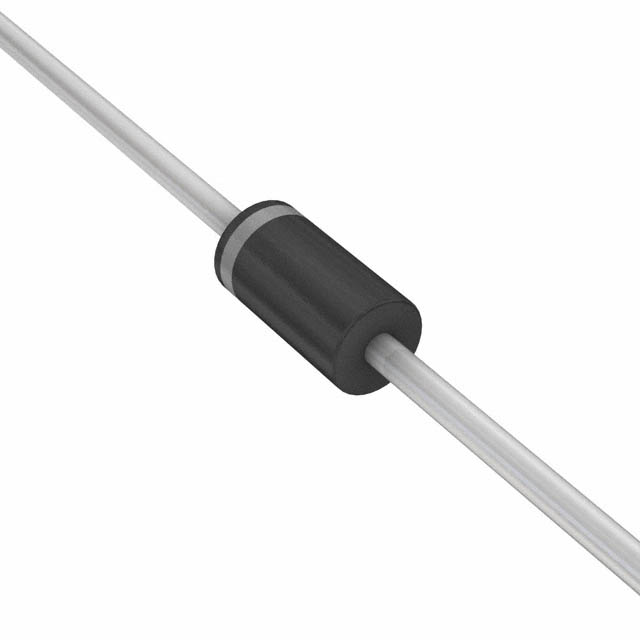P4KE160CAHA0G Encyclopedia Entry
Product Overview
The P4KE160CAHA0G belongs to the category of transient voltage suppressor diodes. These diodes are commonly used to protect electronic circuits from voltage spikes and transients. The P4KE160CAHA0G is designed to provide characteristics such as high surge capability, low clamping voltage, and fast response time. It is typically packaged in a DO-41 package and is available in various packaging quantities.
Specifications
- Part Number: P4KE160CAHA0G
- Category: Transient Voltage Suppressor Diode
- Peak Power Dissipation: 400W
- Breakdown Voltage: 142V to 158V
- Package Type: DO-41
- Packaging Quantity: Available in reels or bulk packaging
Detailed Pin Configuration
The P4KE160CAHA0G diode has a standard axial lead configuration with two leads for connection to the circuit. The pinout configuration is as follows: - Pin 1: Anode - Pin 2: Cathode
Functional Features
- Transient Voltage Suppression: Provides protection against voltage spikes and transients.
- Fast Response Time: Rapidly clamps excessive voltage to protect downstream components.
- High Surge Capability: Can withstand high surge currents without degradation.
Advantages and Disadvantages
Advantages
- Effective protection against voltage transients
- Fast response time
- High surge capability
Disadvantages
- Clamping voltage may not be as low as some alternative models
- Sensitive to reverse polarity
Working Principles
The P4KE160CAHA0G operates by diverting excess voltage away from sensitive components in the circuit. When a transient voltage spike occurs, the diode rapidly conducts, providing a low-impedance path for the excess energy to be dissipated, thus protecting the connected circuitry.
Detailed Application Field Plans
The P4KE160CAHA0G is commonly used in various applications including: - Power supplies - Communication equipment - Automotive electronics - Industrial control systems
Detailed and Complete Alternative Models
Some alternative models to the P4KE160CAHA0G include: - P4KE6.8CAHA0G - P4KE10CAHA0G - P4KE18CAHA0G - P4KE30CAHA0G
These alternative models offer similar transient voltage suppression capabilities but with different breakdown voltages to suit specific application requirements.
In conclusion, the P4KE160CAHA0G transient voltage suppressor diode offers effective protection against voltage transients, making it a valuable component in various electronic applications.
Word Count: 368
10个与P4KE160CAHA0G在技术解决方案中的应用相关的常见问题及解答
What is the maximum voltage rating of P4KE160CAHA0G?
- The maximum voltage rating of P4KE160CAHA0G is 160V.
What is the peak pulse power dissipation of P4KE160CAHA0G?
- The peak pulse power dissipation of P4KE160CAHA0G is typically 400W at 10/1000μs.
What is the breakdown voltage of P4KE160CAHA0G?
- The breakdown voltage of P4KE160CAHA0G is 178V to 196V.
What is the operating temperature range for P4KE160CAHA0G?
- The operating temperature range for P4KE160CAHA0G is -55°C to +175°C.
What are the typical applications for P4KE160CAHA0G?
- P4KE160CAHA0G is commonly used in surge protection for electronic equipment, telecommunications, and industrial control systems.
What is the reverse stand-off voltage of P4KE160CAHA0G?
- The reverse stand-off voltage of P4KE160CAHA0G is 144V.
Does P4KE160CAHA0G have a low leakage current?
- Yes, P4KE160CAHA0G has a low leakage current, making it suitable for sensitive electronic circuits.
Is P4KE160CAHA0G RoHS compliant?
- Yes, P4KE160CAHA0G is RoHS compliant, meeting environmental standards.
What is the package type of P4KE160CAHA0G?
- P4KE160CAHA0G is available in a DO-41 package.
Can P4KE160CAHA0G be used for transient voltage suppression in power supplies?
- Yes, P4KE160CAHA0G is suitable for transient voltage suppression in power supplies and other voltage-sensitive applications.


